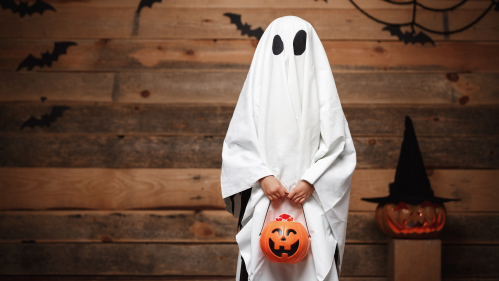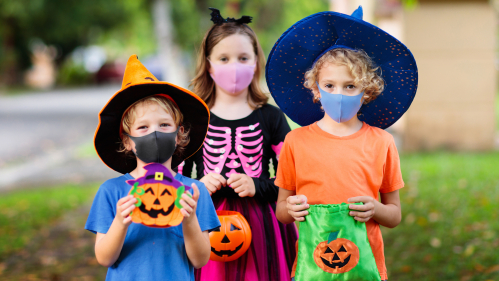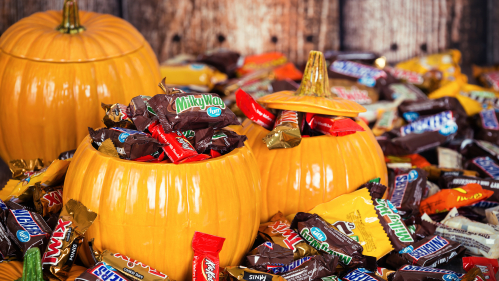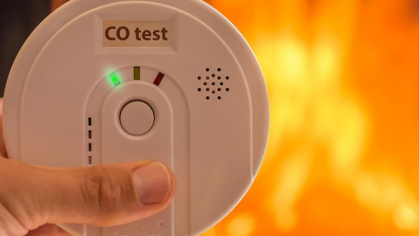How to Have a Safe Halloween

Fear not, trick-or-treaters, Halloween is on in New Jersey.
During his daily coronavirus briefing on Monday, Gov. Phil Murphy announced that traditional holiday revelry is permitted this year provided children and parents take some precautions to reduce the chances of spreading COVID-19. That includes limiting trick-or-treating groups to household members, social distancing when that is not possible and adhering to existing crowd limits on indoor and outdoor gatherings.
We asked Don Schaffner, a Distinguished Professor in the School of Environmental and Biological Sciences at Rutgers University-New Brunswick, Emanuel Goldman, a professor of microbiology at Rutgers New Jersey Medical School, and Henry Raymond, an epidemiologist at the Rutgers School of Public Health, for some tips to enjoy a safe Halloween.

Cover your face with more than your costume.
Schaffner: I've only half-jokingly suggested that this year might be a good idea to come dressed as a doctor or a nurse, or maybe a bank robber. If parents and children can wear masks in addition to Halloween masks this will further reduce the risk.
Raymond: Costume masks aren't designed the same way other masks are. Batman's cowl is technically a mask, but it doesn't cover his nose and mouth, a plastic Casper the ghost mask has holes for mouth and nose. Mummy costumes would be great. Cowboy bad guys with bandanas would benefit from also wearing a mask underneath. Good masks fit snugly around the chin, bridge of nose and cheeks. Not all costume masks do the same.
Goldman: If you are interacting with people outside your immediate home family environment, then yes, masks are in order. The one trick we don't want is transmission of the virus.
The CDC classifies trick-or-treating as a high-risk activity. But outdoor activities are safer than indoor activities.
Schaffner: On the one hand, we know that being outdoors does reduce the risk, so trick-or-treating outdoors is relatively safer than trick-or-treating indoors. We also know that risk comes from spending extended time in close proximity to other people (CDC says more than 15 minutes), so quick interactions walking past others on the street or at front doors should also be low risk.
Certainly, many of the other activities the CDC places in the high-risk category I would agree with, like “Attending crowded costume parties held indoors” or “Going to an indoor haunted house where people may be crowded together and screaming.”
Goldman: The virus primarily spreads airborne from person to person. This is what you need to protect yourself from. As long as all parties are wearing masks and the exchange is done outside, I think it’s OK. It would be high risk without masks.
No matter how creative and cute the trick-or-treaters are don’t have a long conversation.
Schaffner: I think it’s best to distribute candy quickly and efficiently and not spend a lot of time in extended conversations. It’s generally pretty quick at our house: Open the door, drop some candy in the bags, and they’re on their way. I do plan on wearing a (non-Halloween) mask when I go to the door.

Leaving candy out for trick-or-treaters as an alternative is not a bad idea.
Schaffner: It's important to note that there is no activity that is completely safe, so we should always be looking for ways to reduce risk. If someone is concerned about spreading or contracting the virus, leaving small pre-made bags is one idea.
Raymond: Individual packages on a table or tray is the safest way this year because it minimizes contact between those giving out the candy and those getting the candy. It also minimizes the number of hands that touch the candy.
Wash up before eating the candy. Or to allay any concerns, wait a day.
Goldman: The only risk that could be alleged is on the packaging. No one has had concerns about the contents. As for the packaging, most experts are coming around to the position that a modest period of leaving materials undisturbed is sufficient. The research does NOT support any significant transmission by surfaces. The only risk is if an infected person coughs or sneezes on a surface and someone touches that surface within an hour or two, then touches their face without having washed their hands. Even if a surface gets contaminated, the virus dies quickly and will be gone after a day.
Schaffner: We know that there are no documented cases of transmission from food or food packaging materials. The evidence of transmission from surfaces is very limited. The best way to manage risk in this case is to wash your hands or use hand sanitizer on your hands prior to eating your candy.
If you are uncomfortable, sit this year out.
Raymond: I would advise people who feel like it’s risky for them to open their doors and hand out candy to seriously consider turning their light out. The people getting the most potential exposure are the people opening their doors. That one person is opening their door to hundreds of kids.


